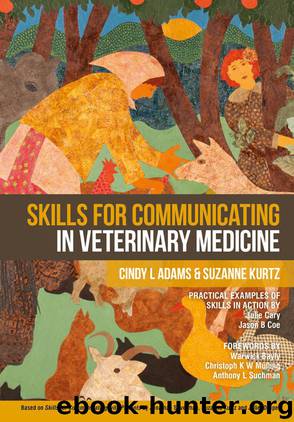Skills for Communicating in Veterinary Medicine by Cindy L Adams & Suzanne Kurtz

Author:Cindy L Adams & Suzanne Kurtz
Language: eng
Format: epub
ISBN: 9781910303139
Published: 2016-09-21T00:00:00+00:00
Box 5.1 Definition of relational coordination
The coordination of work through relationships of :
shared goals
shared knowledge
mutual respect.
Communication that is:
frequent
timely
accurate
geared toward problem solving.
Veterinary researchers are beginning to look at the link between communication, relationships and outcomes in veterinary medicine.
McDermott et al. (2015) used a questionnaire looking at the importance of communication skills to aspects of veterinarians’ personal and practice success. The results showed that 88.2% of respondents assigned a score of 5/5 to the importance of communication skills for client relationships and 64.3% assigned 5/5 to the importance of communication skills for colleague relationships (where 1 = not at all important and 5 = extremely important).
Moore et al. (2014) conducted a study of 48 veterinary clinics (274 team members) regarding the role of veterinary team effectiveness. The four factors of team effectiveness that she measured were coordinated team environment, toxic team environment, team engagement, and individual engagement. They found that coordinated team environment – i.e. team members communicating about their work (conversations, written policies, newsletters), having an opportunity to provide input in challenging situations, and recognizing individual contributions – was associated with decreased cynicism, less burnout, greater job satisfaction and increased professional efficacy.
In a commentary on interprofessional practice, Kinnison et al. (2014) also highlight the importance of teams in veterinary practice, noting that understanding how to work collaboratively and interprofessionally with others on the veterinary team improves team performance and, ultimately, outcomes for patient, client and veterinarian.
Jansen and Lam (2012) call our attention to another aspect of relational coordination. Reporting on a series of studies of mastitis control programs in the Netherlands, Jansen and Lam conclude that the prevention of complex disease requires customized communication strategies as well as integrated communication between stakeholders and different scientific disciplines.
In a study exploring the effect of toxic attitudes and environment on the veterinary healthcare team, Moore et al. (2015) found that a toxic environment contributed to broken communication and tension between staff members. A theme reflected in all veterinarian and veterinary technician focus groups was that in the absence of good communication everything else fell apart.
Moore (pers. comm. 2016) assessed the relationship between relational coordination and job satisfaction, intent to stay on the job, and burnout in small animal veterinary practice. Preliminary findings showed that relational coordination was positively correlated with job satisfaction, intent to stay on the job and professional efficacy, and negatively correlated with exhaustion and cynicism for all employment categories. For this study, Moore and her colleagues drew on work done in human medicine (Gittell et al. 2000; Gittell et al. 2008a and b; Bae and Fried 2010; Carmeli and Gittell 2010).
Best (2015) concludes her study of the communication expectations of equine referral veterinarians and specialists by saying that a focus on relational coordination may improve the outcomes for equine patients, clients and veterinary care providers by focusing on all dimensions of relational coordination, noted in Box 5.1.
Download
This site does not store any files on its server. We only index and link to content provided by other sites. Please contact the content providers to delete copyright contents if any and email us, we'll remove relevant links or contents immediately.
| Administration & Medicine Economics | Allied Health Professions |
| Basic Sciences | Dentistry |
| History | Medical Informatics |
| Medicine | Nursing |
| Pharmacology | Psychology |
| Research | Veterinary Medicine |
The Ultimate Pet Health Guide by Gary Richter(1727)
All Things Bright and Beautiful by James Herriot(1708)
Vet in Harness by James Herriot(1663)
Predation ID Manual by Kurt Alt(1656)
Chimpanzee Politics: Power and Sex among Apes by Frans de de Waal(1480)
Young James Herriot by John Lewis-Stempel(1477)
Veterinary Echocardiography by Boon June A(1378)
All Things Wise and Wonderful by James Herriot(1324)
Creatures of the Rock by Andrew Peacock(1323)
Vet in a Spin by James Herriot(1308)
Zoo Tails by Oliver Graham Jones(1279)
Exotic Animal Hematology and Cytology by Campbell Terry W(1277)
Black's Veterinary Dictionary by Edward Boden(1267)
David Sedaris Diaries by David Sedaris(1240)
Dr. Pitcairn's Complete Guide to Natural Health for Dogs and Cats by Richard H. Pitcairn & Susan Hubble Pitcairn(1166)
Calisthenics: Core CRUSH: 38 Bodyweight Exercises | The #1 Six Pack Bodyweight Training Guide by Pure Calisthenics(1138)
A Handful of Happiness by Massimo Vacchetta & Antonella Tomaselli & Jamie Richards(1124)
Biology and Diseases of the Ferret by Fox James G.; Marini Robert P.; & Robert P. Marini(1096)
Practical Physiotherapy for Veterinary Nurses by Carver Donna;(1035)
